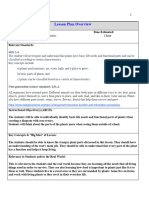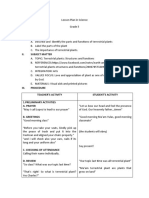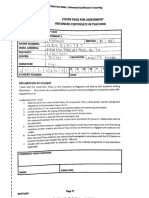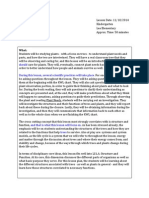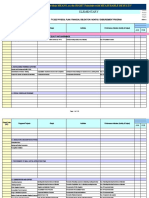University of Houston: Science For Ells
University of Houston: Science For Ells
Uploaded by
Emily StaskaCopyright:
Available Formats
University of Houston: Science For Ells
University of Houston: Science For Ells
Uploaded by
Emily StaskaOriginal Description:
Original Title
Copyright
Available Formats
Share this document
Did you find this document useful?
Is this content inappropriate?
Copyright:
Available Formats
University of Houston: Science For Ells
University of Houston: Science For Ells
Uploaded by
Emily StaskaCopyright:
Available Formats
University of Houston
Science for ELLs
Name: Emily Staska
Basic Lesson Components
Grade Level: 1st
Time Estimate: 45 minutes
Science Content: Plants have many parts such as leaf, steam, roots, flower and seed. The seed
is what helps make new plants. The root is planted in the soil and absorbs nutrients and water
that are needed by the rest of the plant. The stem carries water and nutrients from one part of
the plant to another. The leaves provide food and air to help the plant stay healthy and grow.
The flower is where fruits and seeds come from.
TEKS: 1.10B Compare the parts of the plants
Content Objective(s): Students will be able to determine the different parts of the plant and
their function.
Domjan & Wong (2016)
ELPS: Speaking, mainly speak using single words and short phrases consisting of recently
practiced, memorized, or highly familiar material to get immediate needs met; may be hesitant
to speak and often give up in their attempts to communicate.
Language Objective (s): The student is expected to: practice producing sounds of newly
acquired vocabulary such as long and short vowels, silent letters, and consonant clusters to
pronounce English words in a manner that is increasingly comprehensible.
Vocabulary: Definition: Cognate (T or F): Commented [WSS1]: Please review what a cognate is and
Plant: are the major producers in an ecosystem, and fix this list.
Planta (T) -1
they include trees, herbs, bushes, grasses,
vines, ferns, mosses, and green algae.
Root: that are modified for storage of starch and
water. They usually grow underground as
Raiz (FT)
protection from plant-eating animals.
Seed: a fertilized ovule containing the plant embryo. Semilla (FT)
Given the appropriate growth conditions, it will
become the new plant.
Stem: The stem is normally divided into nodes and Vastago(FT)
internodes: The nodes hold one or more leaves,
as well as buds which can grow into branches.
Nutrients: a substance that provides nourishment essential Nutrientes (T)
for growth and the maintenance of life.
Misconceptions:
Plants are not alive. Trees, grass, vegetables, and weeds are not plants.
Materials/Resources/Technology Needs:
Materials: Flipbook, computer, book, I can eat a whole plant paper, celery, pretzel sticks, spinach leafs,
seeds, strawberries
Book: The Tiny Seed by Eric Carle
Technology: Computer, promethean board
Safety:
Make sure students do play with the food or stick it up their nose.
Domjan & Wong (2016)
5E Instructional Procedures
What Teacher Does: What Students Do:
Engage Teacher will draw a plant on Students will watch the teacher as she
the board. draws a picture of a plant on the
Teacher will draw the roots, board.
seed, stem, flower and leaves. After the picture is done the students
Teacher will ask the students will then begin to tell the teacher that
what she drew. she drew a plant.
After students answer (plant), Students will then use their prior
the teacher will then begin to knowledge to tell us what they know
ask the students what they about plants.
know about plants. They will also tell us what each part
Teacher will ask students if of the plant is such as roots, stem,
they know what each part of the flowers, leaves and seed.
plant does. Students will then listen to the book
The teacher will ask students if “The Tiny Seeds by Eric Carle”.
they can label the plants.
Then teacher will read the book
“The Tiny Seeds by Eric
Carle”.
Explore I will give the students a I can Students will receive a I can eat a
eat a whole plant paper. whole plant paper.
Students will receive pretzel Students will receive pretzel sticks,
sticks, celery, strawberries, celery, strawberries, leafs and seeds.
leafs and seeds. Students will determine what piece of
Students will fill out the paper food goes with what part of the
with the food that goes with flower.
each part of the flower. Students will then label there flower
I will be the facilitator as with the correct terms.
students explore.
Explain I will ask the students what Students will tell me what they
each part of the plant does and explored. Such as the different parts
its function. of the plants and their functions.
As students tell me the answers Students will watch a brain pop video
I will clarify as we go. over parts of a plant.
I will show the students a brain Students will listen to the teacher Commented [WSS2]: Always have students explain and
pop video over the different explain what each part of the plant share first. You only add and clarify as needed. Let students
construct their knowledge.
parts of the plant. does.
Commented [WSS3]: This should be the last thing in
I will explain to the students explain. Use this to clarify.
what each art of the plant does.
Commented [WSS4]: Have students explain first. So,
Elaborate Teacher will tell the students The students will have cards over the have students explain parts of the plant. Then clarify. Then
they will now learn the Life life cycle of a plant and they will put have them explain what each part does. Then clarify. Then
cycle of the plant. them in order in which they think brain pop video.
I will give them a life cycle they go.
activity. When students are done they will
Domjan & Wong (2016)
I will give the students cards explain to me what order they go in.
with a picture of each part of After we discuss as a class we will
the life cycle on the card. watch a brain pop video over the life
Then students will have to cycle of a plant and collaborate again
figure out which one goes first, after that.The students will listen as
etc. the teacher goes over the life cycle of
a plant.
Teacher will go over the life The students will then fill out a Commented [WSS5]: You are just telling them? Why not
cycle of the plant. worksheet over the life cycle have them do an activity first? Remember to always let them
experience before you explain anything. You can give them
Teacher will facilitate as independently. a graphic organizer, or do a card sort first.
students do this activity. Students will be challenged because
Then they will explain to me they will not have the teacher
which order they think it goes modeling it for them.
in.
Then we will have a discussion
on the life cycle of a plant and
we will watch a brain pop over
it so that they can extend their
knowledge. fill out a life cycle
of a plant worksheet.
Evaluate Teacher will model a foldable Students will receive a foldable from
over the different parts of the the teacher.
plants. Students will draw their own plant on
She will draw a plant and its the foldable.
different parts on a foldable. As a class they will label each part of
Then the whole class will the plant.
discuss what each part is and Then they will write about what each
label it. part of the plants function is.
Then the class will discourse
over what each part does and
write it on the correct part.
DRAFT 1
What level of inquiry is your lesson? Explicitly how your lesson is formatted to follow
the identified level of inquiry.
My lesson I believe is level 2 inquiry, students are given a procedure to follow but are
not told where each fruit goes to what part of the plant therefore, the solution is
unknown.
Which aspect(s) of the nature of science does your lesson address? Explicitly explain
how your lesson addressed the identified aspects.
Domjan & Wong (2016)
Plants are in every single part of nature and every climate. Plants are seen in the
Greenland’s, rainforests, deserts. The only place you would probably not see a plant is
in the artic where it is ice all the time.
How did you accommodate linguistically diverse students (ELLs) in this lesson? Why
do you think the strategies you selected will be beneficial to student learning?
ELLs are accommodated in this lesson by ELPS, where I will use only words that they
may know or single words. A lot of teacher modeling is incorporated into my lesson
which is good for ELL students because they do not know much English but if it is
modeled they can follow along.
How did you integrate your students’ home cultures into this lesson?
I integrated my students home cultures in my lesson by allowing the students to tell me
what they know about plants and where they have seen plants. Also by giving the
students a diverse variety of foods to use of their lesson.
Domjan & Wong (2016)
You might also like
- 5e Lesson PlanDocument2 pages5e Lesson Planapi-557273759100% (5)
- 5e Lesson Plan PlantsDocument4 pages5e Lesson Plan Plantsapi-540015241100% (1)
- Assignment (Production & Operations Management)Document28 pagesAssignment (Production & Operations Management)api-370836985% (27)
- Irisortiz 5elessonfinalcleanDocument6 pagesIrisortiz 5elessonfinalcleanapi-506380458No ratings yet
- Parts of PlantDocument6 pagesParts of PlantMahraNo ratings yet
- Developmental Lesson Plan 2Document7 pagesDevelopmental Lesson Plan 2api-545431181No ratings yet
- Jessicamorales 5elessonfinalDocument12 pagesJessicamorales 5elessonfinalapi-529997068No ratings yet
- Geneva Lesson Plan Science 3Document4 pagesGeneva Lesson Plan Science 3api-584574665No ratings yet
- Lesson Plan Format: It'S Harvest Time! by Jean McelroyDocument3 pagesLesson Plan Format: It'S Harvest Time! by Jean Mcelroyapi-511497736No ratings yet
- The Plant Life CicleDocument4 pagesThe Plant Life CicleChileno CrisNo ratings yet
- 7E Lesson Plan TemplateDocument6 pages7E Lesson Plan TemplateRegine Rose Cerico OmictinNo ratings yet
- Annotated-Jalisa 20barner 20final 20lesson 20planDocument6 pagesAnnotated-Jalisa 20barner 20final 20lesson 20planapi-665916389No ratings yet
- Evanssamantha 5elessonpeerreview Oct18Document4 pagesEvanssamantha 5elessonpeerreview Oct18api-403025235No ratings yet
- LESSON PLAN 3.2 Part of The PlantDocument9 pagesLESSON PLAN 3.2 Part of The PlantMaitha ANo ratings yet
- Lesson 1Document4 pagesLesson 1api-218284373No ratings yet
- Edtpa Indirect Instruction Lesson Science 3-18-16Document3 pagesEdtpa Indirect Instruction Lesson Science 3-18-16api-314090527No ratings yet
- Lesson Plan Science PortfolioDocument4 pagesLesson Plan Science Portfolioapi-273332088No ratings yet
- Rylee Ratcliff 5e Lesson Plan 2Document12 pagesRylee Ratcliff 5e Lesson Plan 2api-394675236No ratings yet
- Inquiry Lesson - Lima BeanDocument3 pagesInquiry Lesson - Lima Beanapi-222848521No ratings yet
- LESSON PLAN 3.2 Parts of Plant We EatDocument7 pagesLESSON PLAN 3.2 Parts of Plant We EatMaitha ANo ratings yet
- Final Science Lesson PlanDocument8 pagesFinal Science Lesson Planapi-456570056No ratings yet
- Detailed Lesson Plan in Science3Document6 pagesDetailed Lesson Plan in Science3Johny Alisob SonorNo ratings yet
- SHIRLY Lesson Plan - ScienceDocument5 pagesSHIRLY Lesson Plan - Sciencecarlyn seludoNo ratings yet
- Lesson Plan 1Document4 pagesLesson Plan 1Salama AlneyadiNo ratings yet
- Lesson Plan 4Document6 pagesLesson Plan 4Tracie CoyneNo ratings yet
- Science Lesson PlanDocument4 pagesScience Lesson PlanJoquene HallNo ratings yet
- Parts of A Flowering Plant Lesson 1Document3 pagesParts of A Flowering Plant Lesson 1Riffat Manzoor Abbasi - 93382/TCHR/BIKGF-10/4No ratings yet
- Root - LPDocument4 pagesRoot - LPNicole Carait100% (1)
- Supervisor Observation 2 Read Aloud 1 2Document3 pagesSupervisor Observation 2 Read Aloud 1 2api-395783787No ratings yet
- Lesson Plan Roots and StemsDocument5 pagesLesson Plan Roots and Stemsapi-548691094No ratings yet
- Mid Term AssignmentDocument6 pagesMid Term Assignmentsweta soniNo ratings yet
- University of Houston 5E Lesson Plan: 1. El Otorno (F)Document8 pagesUniversity of Houston 5E Lesson Plan: 1. El Otorno (F)api-506184062No ratings yet
- Educ 380 Lesson PlanDocument11 pagesEduc 380 Lesson Planapi-735464810No ratings yet
- Lesson Plan 5Document4 pagesLesson Plan 5Salama AlneyadiNo ratings yet
- Lesson Plan Roots and StemsDocument5 pagesLesson Plan Roots and Stemsapi-548717522No ratings yet
- Day 6 Science Unit - Lauren HobbsDocument9 pagesDay 6 Science Unit - Lauren Hobbsapi-707644965No ratings yet
- Lesson Plan in ScienceDocument11 pagesLesson Plan in ScienceRose YulasNo ratings yet
- LPS 2Document4 pagesLPS 2zainabfatima5452No ratings yet
- Eoft1624 Ass 2Document14 pagesEoft1624 Ass 2Bonginkosi NyawoNo ratings yet
- Life Cycle of Plant Lesson PlanDocument2 pagesLife Cycle of Plant Lesson PlanIFRAH SALEEMNo ratings yet
- Craig - SLP PlanDocument5 pagesCraig - SLP Planapi-455636012No ratings yet
- Sciencetermiiifinaldraft-Tarynwilliams 1Document7 pagesSciencetermiiifinaldraft-Tarynwilliams 1api-270516233No ratings yet
- FG Division Ranking For Elementary School D: Republic of The Philippines Region III-Central LuzonDocument8 pagesFG Division Ranking For Elementary School D: Republic of The Philippines Region III-Central LuzonKheemi Manzano Pacada LptNo ratings yet
- Grade: 3 Subject: Science Lesson Title: Living and Non-Living TEKS: 112.14. Science, Grade 3, Beginning With School Year 2010-2011Document11 pagesGrade: 3 Subject: Science Lesson Title: Living and Non-Living TEKS: 112.14. Science, Grade 3, Beginning With School Year 2010-2011Anonymous z5XsjimWeNo ratings yet
- Know What The Various Parts of The Plant Are Know The Functions of Certain Part of The Plant and What They Can DoDocument6 pagesKnow What The Various Parts of The Plant Are Know The Functions of Certain Part of The Plant and What They Can DoShay-Ann LewisNo ratings yet
- Plant Diversity: 2nd Grade Science Unit PlanDocument16 pagesPlant Diversity: 2nd Grade Science Unit Planapi-285356517No ratings yet
- Completed Plant Unit Lindsay Adams Ued 400Document32 pagesCompleted Plant Unit Lindsay Adams Ued 400api-105224564No ratings yet
- Detailed Lesson Plan in Science in A Multigrade Class (Grades 1, 2 and 3)Document16 pagesDetailed Lesson Plan in Science in A Multigrade Class (Grades 1, 2 and 3)Marivic PendonNo ratings yet
- What Do Plants Need To Grow Lesson Plan 2-1Document8 pagesWhat Do Plants Need To Grow Lesson Plan 2-1bashaer abdul azizNo ratings yet
- Lesson Plan 1Document3 pagesLesson Plan 1api-345573664No ratings yet
- Lesson Plan Guide: Unit/Chapter Objective/Generalization/Big IdeaDocument5 pagesLesson Plan Guide: Unit/Chapter Objective/Generalization/Big Ideaapi-465055658No ratings yet
- Plants and SeedsDocument6 pagesPlants and Seedsapi-547147781No ratings yet
- 5elessonfinalplants HuynhlindseyDocument13 pages5elessonfinalplants Huynhlindseyapi-400682518No ratings yet
- 2nd M. P. Planning 2011-2012Document10 pages2nd M. P. Planning 2011-2012Hans QuevedoNo ratings yet
- BTW Design FinalDocument7 pagesBTW Design Finalapi-242356907No ratings yet
- Sofia Kolimago Unit 5 Mastery 229922 1482575532Document3 pagesSofia Kolimago Unit 5 Mastery 229922 1482575532api-665181432No ratings yet
- LESSON PLAN 3.2 Part of The PlantDocument9 pagesLESSON PLAN 3.2 Part of The PlantMaitha ANo ratings yet
- If You Hold A SeedDocument2 pagesIf You Hold A Seedapi-239304942No ratings yet
- Outlines of Lessons in Botany, Part I; from Seed to Leaf For the Use of Teachers, or Mothers Studying with Their ChildrenFrom EverandOutlines of Lessons in Botany, Part I; from Seed to Leaf For the Use of Teachers, or Mothers Studying with Their ChildrenNo ratings yet
- CV Examples Uk Shop AssistantDocument8 pagesCV Examples Uk Shop Assistante6zy3n3q100% (1)
- Not 0072024 1342024Document4 pagesNot 0072024 1342024bijeshNo ratings yet
- UNIT 5 Ratio and Proportion Introduction To SIM: Learning ObjectivesDocument2 pagesUNIT 5 Ratio and Proportion Introduction To SIM: Learning ObjectivesFayeed Ali RassulNo ratings yet
- Physiological Changes in Older PersonDocument5 pagesPhysiological Changes in Older PersonKarina DepanteNo ratings yet
- Fy 2022 Elementary WFP PPMP App Sob MDPDocument119 pagesFy 2022 Elementary WFP PPMP App Sob MDPMamaanun PS100% (1)
- Detailed Lesson Plan in 21ST Century LiteratureDocument6 pagesDetailed Lesson Plan in 21ST Century LiteratureStarrky PoligratesNo ratings yet
- DLP - Family MembersDocument7 pagesDLP - Family MembersClea ShyNo ratings yet
- Mbti With DiscDocument6 pagesMbti With Discpbissama2005No ratings yet
- New Usui Reiki Ryoho 1-3: Double Dragon International Reiki SchoolDocument9 pagesNew Usui Reiki Ryoho 1-3: Double Dragon International Reiki Schoolzinazz50% (2)
- Azeb GetachewDocument72 pagesAzeb GetachewzigaNo ratings yet
- Placement BrochureDocument43 pagesPlacement BrochureAditya SinghNo ratings yet
- Scholarships Questions Account Research Credit Cards Adult Budget 1Document10 pagesScholarships Questions Account Research Credit Cards Adult Budget 1api-509540433No ratings yet
- 1 Staffing The Engineering Organization 1Document35 pages1 Staffing The Engineering Organization 1JNo ratings yet
- Applications in Civil EngineeringDocument2 pagesApplications in Civil EngineeringPablo BenitezNo ratings yet
- Proj Proposal IloiloDocument32 pagesProj Proposal Iloilodv vargasNo ratings yet
- Field Observation EssayDocument6 pagesField Observation Essayapi-242064989No ratings yet
- MTech Manual IITGnDocument21 pagesMTech Manual IITGnSreejithRaveendranNo ratings yet
- Theories of Media RepresentationDocument20 pagesTheories of Media RepresentationFilozotaNo ratings yet
- Assessment 2 - 20-03-2023 - 08 - 54 - 33Document92 pagesAssessment 2 - 20-03-2023 - 08 - 54 - 33junileleNo ratings yet
- VT CVDocument6 pagesVT CVapi-257197996No ratings yet
- EntrepreneurshipDocument8 pagesEntrepreneurshipMandal Souvik0% (1)
- Term 1 Term 2 Term 3: Indian Institute of Management Indore Revised IPM CurriculumDocument3 pagesTerm 1 Term 2 Term 3: Indian Institute of Management Indore Revised IPM CurriculumaanbalanNo ratings yet
- Dance, Movement, ArchitectureDocument6 pagesDance, Movement, Architecturestefaniatriantafyll100% (1)
- Beyond Education Newsletter - Aug-Sept 2016Document2 pagesBeyond Education Newsletter - Aug-Sept 2016Esther Endure KabareebeNo ratings yet
- Sal Greco: Worker's Compensation Reimbursement SpecialistDocument1 pageSal Greco: Worker's Compensation Reimbursement Specialistsalgreco22No ratings yet
- MA Media and Communication Studies - ACC 2023-2024 BrochureDocument18 pagesMA Media and Communication Studies - ACC 2023-2024 BrochureAnuktaNo ratings yet
- Audit Report - Department of Early Education & CareDocument62 pagesAudit Report - Department of Early Education & CareShira SchoenbergNo ratings yet
- Assignment Project Management ON Punjab Group of CollegesDocument5 pagesAssignment Project Management ON Punjab Group of CollegesSaima ShabbirNo ratings yet
- Brinkman - Teaching Creatively and Teaching For CreativityDocument2 pagesBrinkman - Teaching Creatively and Teaching For Creativityapi-313698010No ratings yet
































